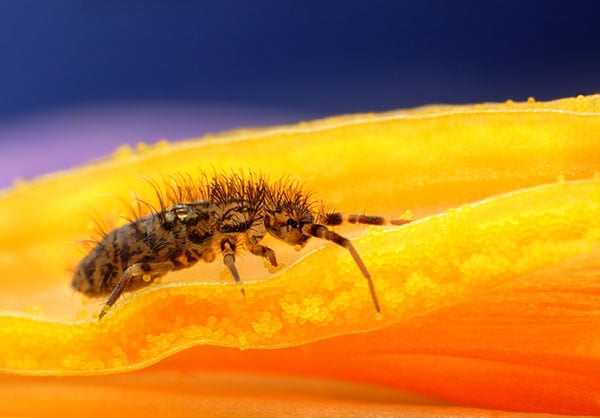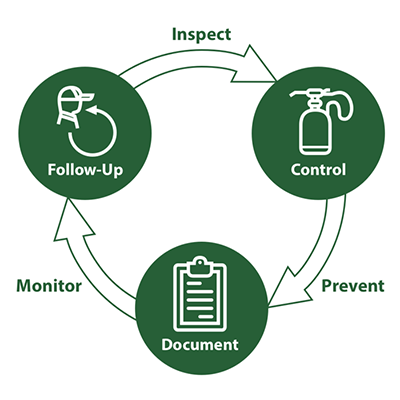Springtails
Appearance And Behavior
Springtails are fungi, moisture, and decay pest hexapods (not insects) that are attracted to areas of high moisture. The name “springtail” comes from the hexapods’ propensity to leap into the air. A springtail only 3/16“ in length can jump three to four inches very quickly in a single leap. They accomplish this using an spring-like appendage called a “furcula” located on their abdomens. Another structure called the “retinaculum” holds the furcula in place beneath the springtail’s abdomen, which builds tension. When the retinculum releases the furcula, this tension makes the furcula “snap” the ground and propel the springtail.
There are thousands of species of springtail, and they’re found all over the world. There are over 675 species of springtail living in the US and Canada alone!
Adult springtails range from 1/32“ to 1/8“ in length. Their soft, compact bodies are wingless and usually white or gray in color. Depending on the springtail species, however, they may also be purple, blue, green, yellow, or orange. Springtails have small eyes. Most springtails have mouthparts designed for chewing, though some may possess mouthparts for sucking or filtering instead.
Female springtails deposit eggs in moist places. Springtail development cycle varies widely in length: some hatch and reach adulthood in as little as one week, while others can take up to two years. Springtails molt five to 10 times before becoming an adult. Even in adulthood, springtails continue to molt throughout their lives. While springtails generally stop increasing in size after their 15th molt, some species may molt up to 50 times.

Springtails inhabit moist or damp areas. Most species congregate together in enormous numbers under patches of soil. They often invade structures in search of moisture when their habitat becomes dry. Springtails enter buildings via door thresholds, utility openings, weep holes, missing mortar joints, crawl space vents, and window screens. They may also hitch rides on potted plants and other items as you bring them indoors.
Indoors, springtails are commonly found in high-moisture areas like bathrooms, kitchens, damp crawl spaces, basements, and wall voids. It’s not unusual to first spot them in sinks and tubs. Moldy bedding, mattresses, couches, and stuffed chairs can support large infestations. Anywhere you can smell mildew could be a target for moisture-loving springtails.
Springtail Prevention

The best springtail control is simply to dry out the site of infestation. Springtails can’t live or reproduce in dry environments for very long. If you can dry out at-risk areas, you’ll make your building far less hospitable to springtails.
Manage mulch placement and lawn irrigation carefully to prevent moisture accumulation near your building. Repair plumbing leaks as soon as you notice them. Patch up drafts, especially in basements and attics. Consider investing in a dehumidifier. If an infestation has already begun, locate and vacuum up any springtails as you find them. Make sure to throw out the vacuum bag when you’re done, or the springtails might spring right back out!
Springtail Control Process
Professionals like the Plunkett’s technicians start by applying exterior perimeter treatments with water-based and granular insecticide formulations. We try to apply these treatments as deep into springtail activity zones as possible to mitigate invasion permanently. We’ll also targe the exterior foundation wall and treat beneath siding at the sill using residual liquid insecticides. If necessary, we may also strategically inject insecticide aerosols into wall voids, thresholds, and other entry points.
Unfortunately, indoor springtail infestations can be difficult to control permanently, especially if structural moisture problems and mold growth persist. If your landscape or structural conditions support springtail propagation, we may recommend a quarterly pest management program.
If you think you may have a springtail infestation, don’t hesitate to contact Plunketts! We’ll spring into action to solve your problem right away. See what we did there? …ok, we promise we won’t make that pun when we come help. But we will solve your springtail problem. Count on it.

Springtail Control With Plunkett's
At Plunkett’s, our goal is to help you quickly, conveniently, and in the most cost-effective way. We make every effort to be with you the same day or the very next day.
Learn More
There are all kinds of different humidity-loving pests. Click on any of the common fungi, moisture, and decay pests to learn more.






